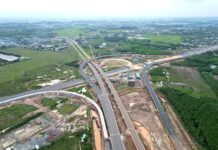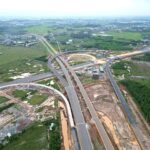The History of Ha Tinh’s Transportation mentions the Li Bi Airfield and the fierce bombings along Route 22 that took the lives of many Youth Volunteers, civilian laborers, and soldiers.
According to various sources, in early 1965, there were only two routes connecting the North and the Southern battlefield running through Ha Tinh: National Highway 1 and National Highway 5. To provide more efficient support, the transportation sector established Route 21.
The strategic Route 22, constructed by the Ministry of Transportation in late 1966, came into being after intense enemy attacks on National Highway 1 aimed at blocking supply convoys heading to Quang Binh. The 65km-long route started from Thinh Thinh junction (now in Nam Dien, Thach Ha district), passed through Ke Go Lake (Cam My, Cam Xuyen district), ran through several communes in Ky Anh district, and ended in Tuyen Hoa, Quang Binh province.
During the construction of Route 22, the national defense forces chose Da Bac area to build the 723 defense project (also known as the Li Bi makeshift airfield). At that time, the Ke Go Lake had not yet been dammed and flooded, so part of Route 22 ran through the future lake bed.
The Li Bi makeshift airfield, associated with Route 22, was determined to be the closest airfield for the North to support the Southern battlefield. However, by the end of 1972 and early 1973, when the airfield was almost complete, it was discovered by the enemy and subjected to intense bombings by B52 bombers. Thus, a key project that had cost countless lives and blood of our military and people was destroyed without ever being used.
In 1976, as peace was restored, the state embarked on the construction of the Ke Go Lake project to develop agriculture. By 1980, all major items were completed, and it officially came into operation in 1983. The Ke Go Lake was formed, submerging the former battlefield.
The Ke Go Lake has a length of 29km, a basin area of 223 km2, and a lake area of over 30 km2. The lake has a storage capacity of up to 345 million m3, including a main dam and three auxiliary dams.
The initial plan for the Ke Go Lake was to complete it in 10 years, which was later reduced to 6 and then 3 years. To meet the urgent deadline, heavy machinery weighing 30-40 tons was deployed to the site, and 30,000 m3 of gravel was mobilized for construction.

Beneath the lake lie countless bomb craters and remnants of Route 22 and the Li Bi Airfield.
On the construction site, there were regularly around 10,000 water resources team members working continuously, along with tens of thousands of people from cooperatives, neighborhoods, agencies, enterprises, schools, and the military who were mobilized on short notice.
To ensure the project was completed within three years, human resources were mobilized according to each locality and cooperative. Each young person contributed a minimum of 30 days of labor per year. Countless trucks carrying people arrived in droves along the forests and rivers.
On February 3, 1979, the Ke Go Lake held a ceremony for the first water intake. Thousands of farmers from Cam Xuyen and Thach Ha districts braved the cold and drizzle to witness the sweet water flow after a long wait. Completing this grand irrigation project in three years was considered a miracle.
The Ke Go Lake serves multiple critical purposes in the region. It provides irrigation for 21,136 hectares of arable land in Cam Xuyen and Thach Ha districts, helps prevent flash floods and erosion in the downstream area, and supplies water with a flow rate of 1.6 m3/s and generates electricity with an installed capacity of 2.3 MW.
Undoubtedly, the Ke Go Lake’s creation has brought not only practical benefits to the economy and industry but also significantly contributed to environmental improvement and enhanced the natural beauty of a vast area.
In 2005, when the lake’s water level dropped, some fishermen discovered traces of graves and hundreds of large and small bomb craters, testifying to the brutality of the past air raids.
Today, the Ke Go Lake not only plays a crucial role in providing clean water to the local population but has also become an attractive tourist destination. Visitors coming here can immerse themselves in the fresh and cool atmosphere and listen to the heroic historical stories of a unique makeshift airfield.
The Electric Car Revolution: Unveiling Ha Tinh’s Upcoming Metropolis and Auto Manufacturing Hub
The Ha Tinh Provincial Party Executive Committee has approved the proposal to establish Ky Anh City and greenlit a significant investment in an electric car manufacturing plant. This decision underscores a commitment to fostering urban development and embracing innovative, sustainable industries. With a total investment of approximately VND 7,300 billion, this project promises to be a transformative initiative, shaping the future of the region and positioning it at the forefront of Vietnam’s evolving automotive landscape.
Taiwanese Firm Plans $100 Million Factory in Ha Tinh Province
The Dai Loi Pho Group, a leading developer and supplier of sports footwear materials, is eyeing the Lac Thien Industrial Cluster in Duc Tho District, Ha Tinh Province, as the potential site for their new factory. With an estimated area of 30 hectares, this new development promises to be a significant addition to the region’s industrial landscape.







































